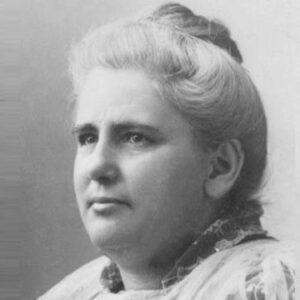Anna Howard Shaw was an American physician and a pioneer of the American women’s suffrage movement. A woman of many facets, she was also one of the country’s first ordained female Methodist clergy. A firm believer in gender equality and a fighter for women’s rights, she was an independent-minded intellectual woman. Along with another prominent feminist, Susan B. Anthony, she was a co-founder of the National American Woman Suffrage Association. Shaw had risen from a rough childhood to become a well-educated and self-confident woman. She began her profession as a teacher but soon found her true calling was preaching. She followed her heart despite her family’s disapproval. Eventually, she was ordained in the Methodist Protestant Church and established herself as a successful preacher. She then pursued a medical education and became a physician. By this time, she had developed an interest in the growing women’s suffrage movement in the United States and had become an ardent supporter of women’s political rights. Women’s suffrage was her passion, and she spent the remainder of her life working for it.
Childhood & Adolescence
She was born in Newcastle-upon-Tyne, England, on 14 February 1847. Her family came to the United States when she was four years old and settled in Massachusetts. She has a large family.
She endured a traumatic upbringing. Her father was largely absent, and her mother experienced a psychological breakdown after becoming incapable of caring for the children alone. Their misery was exacerbated by a brother’s illness.
She was a diligent and hardworking young lady who not only took care of household chores but also carried out physically demanding tasks such as digging wells and chopping firewood.
During the Civil War, her elder brothers enlisted in the war, and she was left financially responsible for the family. Thus, at the age of 15, she became a school teacher.
She opted to pursue higher education following the Civil War and relocated to Michigan with her married sister. She completed high school and also worked as a seamstress.
Anna Shaw’s Career
During this time period, she also developed an interest in preaching, which was sparked by Reverend Marianna Thompson’s encouragement of her educational pursuits. When she was 24, Dr. Peck invited her to deliver her first effective sermon.
However, her desire to preach drew the ire of her friends and family. Nonetheless, she listened to her heart and continued to preach.
Her employment as a preacher enabled her to accumulate money for higher education, and she enrolled in Albion College, a Methodist school in Albion, Michigan, in 1873.
In 1876, she enrolled in the School of Theology at Boston University. There, she was the only female in her class and thus frequently faced discrimination. It was a trying moment for her, since she was financially unable to sustain herself. Despite this, she persevered and graduated in 1878.
She took over a congregation in East Dennis, Massachusetts, following her graduation. Again, she encountered prejudice, when the Methodist Episcopal Church’s New England Conference and General Conference declined to ordain her due to her gender.
Finally, in 1880, she was ordained in the Methodist Protestant Church, making her one of the country’s first ordained female Methodist preachers.
She enrolled at Boston University and earned an M.D. in 1886. While attending medical school, she became an active member of the women’s rights movement, pushing for women’s political rights.
During the late 1880s, the women’s suffrage campaign was gaining strength, and she chose to leave pastoral work to join the cause.
She became a lecturer for the Massachusetts Woman’s Suffrage Association and served as the Women’s Christian Temperance Union’s national supervisor of franchise from 1886 to 1892.
She met and was significantly affected by prominent feminist and activist Susan B. Anthony. Both ladies were committed to the cause of women’s suffrage, and she was appointed vice president of the National American Woman Suffrage Association in 1892 and president in 1904, where she served until 1915.
The number of suffrage workers increased from 17,000 to 200,000 during her rule, and ten campaigns were held each year. The entire suffrage movement gathered momentum and captured the nation’s attention.
During World War I, she chaired the Woman’s Committee of the Council of National Defense and was awarded the Distinguished Service Decoration in 1919 for her wartime service—the first woman to earn the prestigious medal. After the war, she continued to lecture for women’s suffrage.
Personal History and Legacies
In 1919, while on a speaking tour, she caught pneumonia. She died of the sickness on 2 July 1919, in Pennsylvania, at the age of 72.
A few months after her death, the 19th Amendment was enacted, granting women in the United States the right to vote. However, she was aware at the time of her death that the goal she was pursuing was close to being accomplished.
Estimated Net worth
Anna Howard Shaw’s net worth is estimated to be $ USD 6 million, with her primary sources of income being as a theologian, suffragette, physician, pastor, autobiographer, and suffragist.


